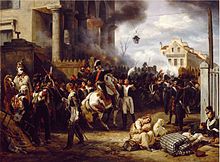Père Lathuile
The Père Lathuile (also spelled Lathuille ) was a café-restaurant in Paris . It was located on Avenue de Clichy in the 17th arrondissement .
history
In the place of the later café-restaurant there was initially a farm that belonged to the hamlet of Batignolles and supplied the city of Paris with milk. Here, in 1765, the pub ( cabaret ) Au père Lathuile opened , which was mainly visited by the Parisian population, as the taxes here were lower and alcoholic beverages were cheaper than in the capital. In 1814, the Père Lathuile played a role in the Wars of Liberation , when Marshal Bon-Adrien-Jeannot de Moncey moved into his quarters in Père Lathuile to defend Paris against the advancing Russian troops. A monument to de Moncey was later erected on the nearby Place de Clichy . Before the battle of the Barrière de Clichy broke out on March 30, 1814, Pierre Lathuile, the owner of the restaurant at the time, had food and drinks distributed to the soldiers. From him the saying has been passed down: "Mangez, buvez, mes enfants, il ne faut rien laisser à l'ennemi!" (Analogous translation: eat, drink, my children, we don't have to leave anything to the enemy ). The painter Horace Vernet portrayed the French troops in front of Père Lathuile in his painting La barrière de Clichy. Défense de Paris, perpetuated on 30 mars 1814 ( Louvre ). In the background of the picture from 1820 appears the facade of a house with the pub sign and on it the misspelling of the name Au Père Lathuille . The military actions under Marshal de Moncey also served as a motif for the one-act play Le Père Latuile, ou le Cabaret de la barrière de Clichy by Adolphe de Leuven . The inn already appears in the title. The first performance of the play took place on December 3, 1835 in the Parisian Théâtre de la Porte-Saint-Martin . During the 19th century, the Père Lathuile developed into a café-restaurant and, like the neighboring Café Guerbois, was a popular meeting place for artists. The painter Édouard Manet created the painting Beim Père Lathuille, in the open ( Musée de Beaux-Arts , Tournai ) in 1879 and also misspelled the surname in the title. The picture shows a young couple flirting in the garden of the café-restaurant. The Père Lathuile existed until 1906. After that there was the Music Hall Le Kursaal , which existed until 1927 and where vocal artists such as Maurice Chevalier , Fréhel , Lucienne Boyer and Berthe Sylva performed. The building has been used as a cinema since 1930, trading first as Eden , then as Mirage and later as Pathé Clichy . The arthouse cinema Cinéma des Cinéastes has been located here since 1996 . At 7 avenue de Clichy a plaque commemorates Le Père Lathuille . The alley branching off on the opposite side of the street is named Passage Lathuille after the former restaurant .
literature
- Pierre Andrieu: History of the restaurant in France . La Journée Vinicole, Montpellier 1955.
- Richard Khaitzine: Galeries et passages de Paris: à la recherche du temps passé . Le Mercure Dauphinois, Grenoble 2010, ISBN 978-2-35662-032-3 .
- Gérard Letailleur: Histoire insolite des cafés parisiens . Perrin, Paris 2011, ISBN 978-2-262-03548-8 .
- Béatrice Malki-Thouvenel: Cabarets, cafés and bistrots de Paris: promenade dans les rues et dans le temps . Horvath, Le Coteau 1987, ISBN 2-7171-0511-5 .
- Henriette Parienté, Geneviève de Ternant: La fabuleuse Histoire de la cuisine française . Odil, Paris 1981.
- Jules Renard: Journal 1887-1910 . Gallimard, Paris 1965.
Individual evidence
- ↑ Béatrice Malki-Thouvenel: Cabarets, cafés et bistrots de Paris: promenade dans les rues et dans le temps , p. 38.

